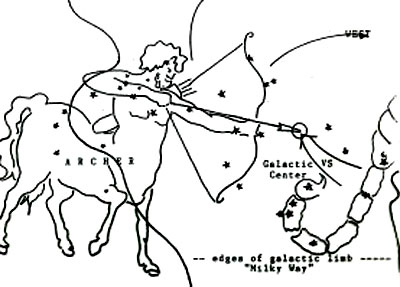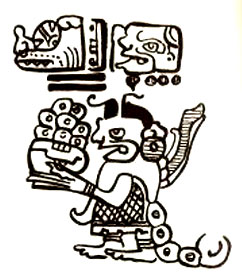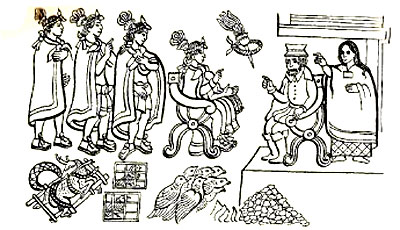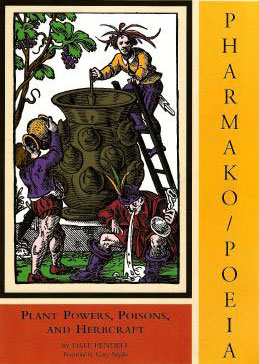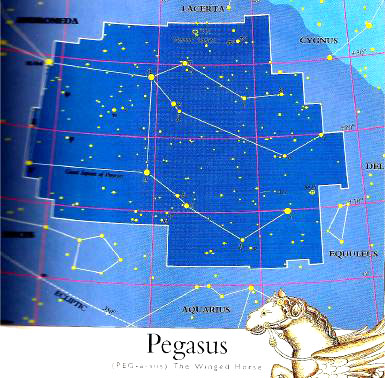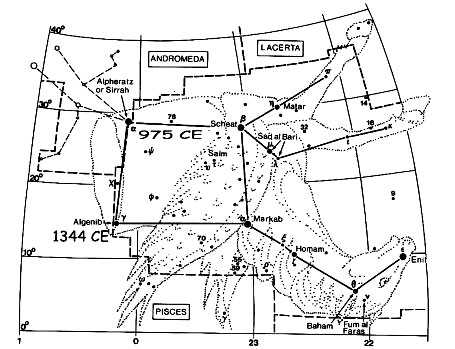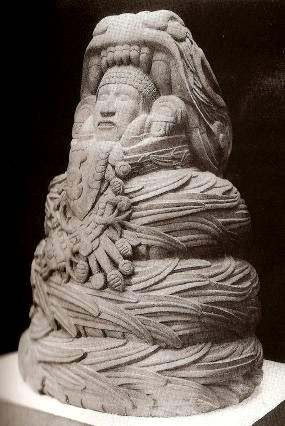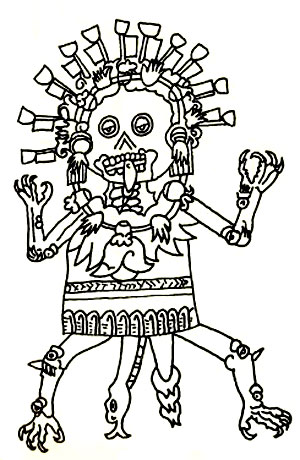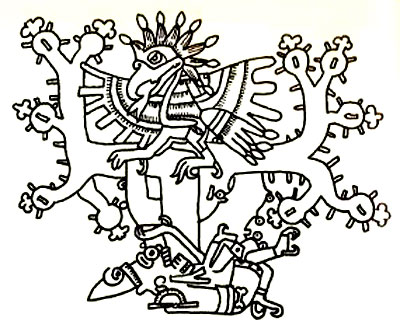|
by John Lash from MetaHistory Website
I pointed out that the "lesser" Kali Yuga that began in 3102 BCE is contiguous with the start of the Mayan Long Count. The length of the lesser Kali Yuga is one-fifth of the full precessional cycle or Kalpa: 72 degrees of precession at one degree every 72 years = 5184 years.
This figure closely matches the average
duration of the five Aztec Suns and the Maya period of 13 baktuns of
144,000 days each. To the Hindu-Maya-Aztec correlation I then added
the Egyptian factor, encoded on the
Dendera Zodiac by axis D through Antares, also dated close to 3102 BCE.
When the autumnal equinox coincided with Antares around 3023, Kali Yuga began. At the same moment, the spring equinox coincided with Aldebaran in the eye of the Bull, exactly opposite to Antares. I have suggested that the Antares-Aldebaran axis defines the formal structure of the Zodiac.
The alignment of precessional timing to
this axis is a strong signal that highlights the moment of entry
into the lesser Kali Yuga.
From midnight into the wee hours of the morning, I see the Scorpion composite down to the full extension of its massive tail-hook, cart-wheeling left to right over the rugged mountains of Africa.
With this view I can confirm an observation made years ago in the crystalline air of the Sangre de Christos mountains of New Mexico:
Observing the composites to learn astronomy is one thing, but at the same time, and quite spontaneously, the constellations trigger an act of imagination in which the graphic figures (the Zodiac: "cycle of animations") spring to life.
I have found that the graphic and gestural actions suggested by these massive star-patterns speak for themselves, and seem to communicate things that cannot always be put into words.
For instance, you will notice that the Archer aims over the terminal star of the stinger, upsilon, toward epsilon in the torso.
The faint star gamma marks the tip of his arrow, so there is no mistaking the line of aim. The centaur armed with bow and arrow does not shoot for the heart of the Scorpion, nor even the tail where the poison is most concentrated, and delivered. He aims for the lower trunk of the Scorpion.
What does such a gesture say?
The Maya Codex Tro-Cortesianus presents the stellar archetype of the Scorpion "the old goddess with the scorpion's tail" (Hamlet's Mill, facing p. 291).
Although there are some references to a
thirteen-figure Aztec Zodiac in MesoAmerican lore, I have been
unable to make a consistent match with Greco-Latin composites, but
this one is certain.
R.H. Allen (see below) notes the alignment of Egyptian and Grecian temples to the Scorpion,
It is tempting to link the gruesome
Aztec obsession with human sacrifice with the Scorpion, but I think
this is a wrong direction to go. Nothing in the extant mythology on
the Aztec custom of sacrifice, and the presumed reasons for it,
points to this figure.
Perhaps, however, this constellation
encodes some information about the hidden cause of those practices,
a murky tale of intoxication and black magic. Scorpionic myth may
indicate the morbid pathology behind human sacrifice, but not the
practice itself.
This is precisely the date of the arrival of the Aztecs in central Mexico, although some estimates put this event three centuries earlier, around 950 CE, a date which I prefer. The historical date attached to the Toltec culture hero Quetzalcoatl is 950 or so.
If the Aztecs (or Chichimecs, "dog
people," later to be known as Mexica, pronounced Mesheeka, "moon
people") did arrive as refugees in the Valley of Mexico as early as
950 CE, which I believe to be so, they did not rise to power until
three centuries later, around 1250, the date indicated by
Williamson.
They may actually have been the Anasazi,
"the vanished ones" of the American southwest who attempted to
relocate in a more southern clime after a natural catastrophe,
drought, or whatever...
This was also the precise moment of the consolidation of the warrior class of samurai in far-off Japan. By 1200 Japanese military orders reigned all over feudal Japan, the mirror counterpart to the Eagle and Jaguar societies among the Aztecs at the precise same moment. The odd mix of lethal violence with high aestheticism among the Aztecs ("flower wars") had its exact counterpart in feudal Japan.
Miguel Leon-Portilla, the one
scholar who captures most intimately the spirit of Aztec society,
translates Aztec poetry on the beauty and transience of life that
could well have been written by a samurai about to commit seppuku,
ritual suicide.
The great irony of the conquest of Mexico is that Cortex brought to the natives a salvationist religion comparable in every respect to the sacrificial warrior code and ritual cannibalism it displaced. In fact, Cortez' religion had a glorified sacrificial victim as its central figure, whose body was eaten by its devotees.
This parallel may go a long way to explaining why Christianity had a fatal captivating effect upon a culture toxically enmeshed in human sacrifice.
Double Doom
Montezuma with
Cortez, Malinche interpreting. I wonder who will be able to delve more deeply into the historical enigma of the conquest of Mexico as 2012 approaches.
I wonder also if the bizarre fate of the Aztecs may be reflected in the death wish of Western culture in the remaining years of the Kalpa. My own theory, for what it's worth, is that the Mexica were double-doomed: first, because the nobles and chiefs who rigidly controlled that society were poisoned by chocoholism, and second, because the entire culture was jinxed by the Toltecs with the "return myth" of Quetzalcoatl.
About all this baffling business, I will
have more to say at the end of this essay.
A small frieze in the wards shows a scorpion attending a woman who undergoes an operation with her legs spread.
Imagine this:
Nothing like a little Egyptian folk lore to whet the imagination...
We have to go much deeper than anecdotal
lore to understand what manner of mother love resides in the heart
of the Scorpion, but such insight might direct us wisely on the way
into extinction.
Pendell observes - as I did in Ch. 18 of Not in His Image, discussing the role of the divine scapegoat in victim-perpetrator bonding - that,
It appears that the Scorpion, a poisonous insect, is not the image or origin of "the root illness," but image of our psychosomatic propensity for both lethal and healing poisons.
Is this why the Archer does not aim for the heart of the Scorpion?
In one sense, the stellar archetype of
the Scorpion, taken as a prime indicator of Kali Yuga, points to the
tremendous healing potential for humanity in this Age. It also
points to the extremes of addiction that our species can manifest.
As anyone who has gone through recovery will tell you, we will have
to bottom out as a species to discover and claim that potential.
But the effect depends on the dose, and a potentially toxic plant such as Datura inoxia, jimson weed, can be used to heal and induce visions when it is administered in the right way. As far as I know, a good many psychoactive plants are not poisonous at all, even in strong doses. Psilocybin mushrooms, for instance.
But Pendell's emphasis on poison is sagacious and fits the modern situation, the endgame of poisoning and pollution being enacted under the sign of the Scorpion. Consistent with Pendell's magnificent opus, I would suggest that the Scorpion oversees our end-time experience because, having become toxified in so many ways, we need to understand how to invert the toxification process, beat addiction, heal ancient wounds, etc.
The Archer does not kill the Scorpion
with a heart-shot. He leaves the stinger to deliver the fatal dose,
or the healing dose, as it is measured out.
As 2012 approaches, we are living out this theme on a global scale.
One example:
Mother Scorpion brings healing
and regeneration in the basket of sacred plants offered by the 13
Indigenous Grandmothers whom Joanna is interviewing on
futureprimitive.org.
What I would add here is yet another Scorpionic twist.
Mother Scorpion guards the path of rebirth:
This being so, we would do well to
examine our beliefs about life after death, to see if they are
compatible with the Mother's way, or if they compel us to other
concepts of post-mortem survival - immortality of the soul
guaranteed by the father god through the death and resurrection of
his son, for instance.
I would suggest that her way is a regenerative recovery process, biopsychic and biomystical, an occult process in which she reworks the evolutionary capacities of the entire human species and reconfigures high-end potential in individual genetic endowments. In other words, she effectuates rebirth for the genomic potential of the species, but not for individual human beings possessed of single-self identity.
"The souls of the newborn" are
recycled
human potential, deathless capacities for renewing and extending the
evolutionary experiment of Gaia's life-process over the long term.
This error signals the messianic madness of the Piscean Age and represents (so far) the worst extrapolation of that madness. If we look for divinity in an extrahuman realm, blind to the evolutionary endowment of our own species, we cannot possibly get through an extinction event. Gnostics taught, not that we are divine in our selves, but in our faculties.
We each carry the superhuman potential
of nous, divine intelligence.
This is perhaps the paramount knowledge to be won in the moment of opportunity offered by the 2012 Endtime.
While this may appear to be a terribly
obscure or arcane subject, extremely difficult to conceptualize, the
key to Gaian transpeciation, as I will call it, is written in the
code of the stars.
The composite of Aquarius is dim and shambolic. Scanning its upper region, you find it hard to visualize a head of any kind. Unable to fix on the suggestion of a form, the eyes wander to more distinct stars. Observing the composite of Aquarius, you will inevitably find your eyes shifting upward and to the left where brighter stars entrain your gaze.
This happens by itself, because the mind automatically seeks patterns formed by stars in an area that can be encompassed in one glance, without needing to shift your eyes.
Such an area is the Pegasus square, above the constellation of the Fishes, to the left of Aquarius.
A splayed L-shaped extension identifies
the head of Pegasus, pictured in Greco-Latin star lore as a massive
horse flying upside down. (Pegasus: Skywatching by David Levy,
1996)
The tablet contains three scribble-lines to suggest cuneiform writing.
Thus, if the script of human destiny is encoded in the overall design of the Dendera Zodiac (as I claim), it is also specifically displayed by an image within the design.
To read the skywriting is to trace the
long-term patterns of human evolution. I maintain that the depiction
of the tablet at Dendera indicates that a socially communicable
method of decoding the Zodiac becomes necessary, and possible, in
the final centuries of Kali Yuga. The tablet of destiny is both read
and written in the decisive moment when our species faces the sixth
extinction.
How does this indigenous theme relate to
traditional material on Pegasus?
What? A fallen women in the mix!
Does this figure not bring to mind the fallen goddess, Sophia? The starry plot thickens. This star is called Alpharetz.
Although it does not lie on the ecliptic where precession is measured, Alpharetz like all stars has an ecliptic alignment and its position can be measured in ecliptic degrees. Its ecliptic longitude in 2000 CE is 14.31 degrees. This means that at some time in the not-too-distant past, the spring equinox (VP) was aligned to Alpharetz.
Using the rate of 71.632 degrees per annum, we multiply this figure by the current distance from the VP, 14.31 degrees, and get 1025 years. Subtract this from 2000 CE (epoch of current longitude) and we get 975 CE. This is seven years from 968 CE which I suggested for the most probable date to associate with Parzival's attainment of the Grail, i.e., instruction by the Organic Light, the primary substance body of the fallen goddess, Sophia.
To put it in mythographic lingo, the attainment of the Grail in medieval legend was timed to the VP's alignment with the head-star of Andromeda, a cognate of the divine Sophia.
Now we're on to something, because 975 CE falls in the time of the historical avatar of Quetzalcoatl, the Toltec prince Ce Acatl, said to have been born in 947 and to have undergone, like Christ, a voluntary sacrificial death about 50 years later.
The Quetzalcoatl legend is a messianic tale of the Piscean Age that mixes historical and mythological elements, as does the legend of Jesus Christ, to whom Quetzalcoatl is often compared.
This is fine and lovely for those who want to reconcile all the great religions into a single benign system, but the urgent question is,
The above line-drawing of Pegasus (Julius D. W. Staal, The New Patterns in the Sky) shows clearly how Alpharetz, the head-star of Andromeda, forms the upper left hand corner of the Square.
The composition of the stellar pictures, the result of deliberate visualization, links the record of human evolution to the figure of the fallen goddess. It is particularly revealing to apply the method of star-timing to this configuration. We can read the Square mythologically, but also in terms of historical events timed to the composite stars.
Of the four stars in the Square,
Alpharetz and Algenib (below it), generate dates in time past, while
Scheat and Markab generate dates in the far future. The dating of
965 CE for Alpharetz alerts us to the Parzival-Quetzalcoatl parallel
in the 10th Century, as just noted. It is a "fortunate sign" in the
heavens, reminding us of how humanity is guided by those who
encounter the Organic Light, or misguided by black magical games and
messianic pretences.
Of the many events unfolding at that time, one comes forcefully to the front:
Whatever one thinks of star-dating, or my mythological reading of the constellations, it is undeniable that the tablet of destiny generates these two dates and hence juxtaposes two motifs illustrated by historical events:
I am simply placing the historical
moments signaled by star-dating in a narrative frame, with the
intention of learning what can be learned from such an exercise in
"creative mythology" (a la Joseph Campbell).
An article on the Net, "The Critical Mass of Enlightenment" by John Hogue, lists messiahs from diverse cultures:
Other examples could easily be added, coming down to more recent times.
For instance, there is Bahullah, the
prophet of Bahai, a syncretic belief system declaring the unity of
all religions (see below). Any number of New Age masters including
Sai Baba,
Muktananda,
Rajneesh, and even
Ramtha (channelled by J. Z.
Knight), and
Louis Farrakan, the leader of Nation of Islam, are some
examples that come readily to mind.
They represent,
All of which sounds wonderful if you don't really look at how the messianic complex actually works, and how it has worked for many centuries. The complex always sets up expectations that stand diametrically opposed to what it delivers. Enlightenment and a global shift of consciousness are precisely what these male messiahs do not offer.
Rather, they come and go and leave humanity enmeshed ever deeper in delusional beliefs about divinity, guidance, salvation, equality, justice, and compassion.
The Plumed Serpent,
Mexico, c 1500. Shown Hogue's statement is as cogent a formulation of the Piscean messiah theme as you are likely to find.
Back in the heady 1970s in Santa Fe, I used to call this theme the Master Scam, with a gentle poke at the notion of a Master Plan. Well, perhaps not so gentle. The coming of avataric messiahs is widely believed to be the dominant spiritual event of the Piscean Age. I characterize it as the prevailing con of the Age, the mark of a deeply insidious pathology that deviates us from our true potential as agents in Gaian co-evolution.
Belief in messiahs is precisely what we
need to get over to meet and master the evolutionary challenges
facing humanity in Piscean terms.
Platitudes and pompous commands aplenty, but no genuine instruction about the wisdom of the living. They do not, for instance, teach us what the collapse of bee colonies or the beaching of whales means for human survival. They do not explain how clouds work over the ocean (this being one of the great unsolved aspects of Gaia theory). They do not argue that birth control is essential for the survival of a species whose sexual activity has largely been liberated from the cycle of female estrus.
The valid and loosely rational moral
virtues they do propose could be worked out by anyone with a half
nickel of common sense and a moderate dose of compassion. What we
get from the messiahs, those hippie hypemen of cosmic good, is a
tepid rehash of benevolent social values, usually dressed up with
promises about what God will do for us if we behave ourselves.
Yet the pretence of conferring benevolent social values is always attached to messianic figures.
We look to them for the guidelines by which to live, yet the main challenge of the Piscean Age is to find the guidance we need in individual ourselves, i.e., to become self-guiding, self-reliant in the sense Ralph Waldo Emerson tried to elucidate.
This is the challenge stated by Joseph Campbell in Creative Mythology when he invoked,
The Grail Quest is also a narrative of the Piscean Age, but what a different message it carries from the usual run of messianic tales! What a departure this racy fable of stumblebum self-initiation makes from the Master Scam.
Contrast it also with the Aztec narrative:
Consider these story-lines, and reflect on where each one might lead
you were you to adopt it as the narrative frame of a spiritual
belief system.
All messianic tales are examples of the Master Scam, but in this case the plot seems to have been deliberately implanted in an enemy culture, whereas generally a whole culture or race will be converted to such a messianic belief system by another culture or race attempting to absorb it.
Conversion to a messianic agenda usually profits the conquering
culture or race, because messianism is always aligned with an
agenda of perpetration and domination, but for the Aztecs it was
their undoing.
They were certainly not forced into it by another people who wished to conquer them. In the end, the myth itself conquered the people who adopted it. It worked like a post-hypnotic suggestion, causing the entire Aztec culture, and especially the ruling class, to collapse psychically when faced with the return of Quetzalcoatl in the guise of Cortez.
This is unique, and quite bizarre, but
so is just about everything else we learn about the rise of the
Aztecs and the conquest of Mexico by Cortez.
I consider it mistaken to link the coming of Quetzalcoatl with the 2012 end-time, because the return has already happened. It's over and done, having been enacted in what is perhaps the most bizarre historical drama in human history, or at least in recent history.
However, the 2012 end-time may be the
moment when we finally come to understand what did happen in the
conquest of Mexico.
According to Olin Karch, author of "Prophetic Dates Given by Toltecs and Aztecs," the first of thirteen heavens began in 1168, an alternative date assigned to the historical avatar of Quetzalcoatl by Mayanist Herbert Spinden.
The 13th era of 52 years computing from this
date was 1844-1896, when Baha'i arose. This is yet more messianic
hype for the Master Scam, the spiritual affliction of the Piscean
Age.
The predicted return involved a sacrificial religion of male-warrior dominance that mirrored Aztec society down to its terrible, twisted core. You could say that Montezuma met his daimonic counterpart in another warrior dedicated to a religion of dominance, Hernando Cortez. The expectation of Quetzalcoatl's return set the Aztec chief up for a game of powerlessness, despair, and confusion, easily won by his alien double.
Somehow, the Toltec seers saw that the Aztecs would be defeated by a belief system uncannily similar to their (the Aztecs') own - or defeated by their own beliefs, transposed into a different frame, personified by different players.
What a fantastic twist.
Fine, make up your own stories. Use star-timing to plot it, if you care to, or can. Elucidate the beliefs encoded in the narratives and plots you offer, if you dare to be that transparent. But bear in mind, whether or not you like my stories, they are not really mine: they are drawn from a repertoire of themes deposited in the human psyche over thousands of years of evolution.
They are variants of the phylogenetic record, the indigenous narrative of humanity. The tablet of destiny is an explicit image of the phylogenetic record. Reading it mythologically is one way to go. Reading it mythopoetically is another. There are other ways to read it as well...
But read it we
must, otherwise how will the path through extinction, the way of transpeciation, be discovered?
In Not in His Image, I have argued the parallelism Shakti-Gaia-Sophia because I think it fits our need to see Gaia in terms of the Tantric vision of life.
Tantrikas devoted to wild, ecstatic contact with the Gaian goddess of wisdom will also be on intimate terms with the Devouring Mother, the destroyer aspect of Sophia.
The Aztecs knew her as Tzitzimitl,
a bloody-mouthed demon of the night pictured with a necklace of
beating hearts (Codex
Magliabecchiano).
Images of female divinities are
plentiful enough in the Aztec pantheon, but they do not add up to a
coherent portrait of the earth goddess. I suspect that the
imagination of the Mexica had been occluded by black magical
operations involving the imposition of a male warrior cult centered
on Nanahuatl, the insatiable, blood-drinking sun. This god, pictured
with hideous suppurations, probably represents the sun marked by
sun-spots,
He compelled his uncle, Izcoatl, to burn the sacred codices of the Toltecs and write the history of Mexica to legitimate the male warrior mystique and solar heart sacrifice (The Conquest of Mexico, Hugh Thomas, p. 25)
Before their
books were burned by christian missionaries who converted them to
a
different sacrifice cult, the Aztecs had burned the books of
the Toltecs.
The psychospiritual trauma of such actions is devastating for our species.
The entire range of messianic myths represents overwriting of the indigenous record by a human-authored agenda. In Sharing the Gaia Mythos, I emphasize that genuine creative mythology - i.e., directive myth that can educate and guide our species in ways compatible with its true potential - has no author.
The return myth of Quetzalcoatl
was constructed by Toltecs sages who, I would guess, understood the
phylogenetic record in the way that shamans do in many cultures,
namely, in visionary trance induced by the ingestion of psychoactive
plants. They saw the record and they also saw how to overwrite it
and set up the Aztecs for a catastrophic plunge from power. This has
to be one of the consummate feats of magical realism of all time.
(Also the time: the generic mythological of humanity is complex and expansive. Even local and regional myth is extremely dense, demanding years of close scrutiny. Brundage identifies eight cycles of Aztec myth, of which the Quetzalcoatl story is but one, and not the most revealing.)
Decoding myth is no job for amateurs, but planetary mythmaking is an open source process in which many people can participate.
I would love to teach how to do this in
real life, with the benefit of reception and collaboration from a
community of people who interact with me directly, in flesh and
blood, but that is not the case, so I am teaching it as best I can
in the sterile medium of cyperspace...
Take the image of the eagle on the nopal tree, the central motif in the foundation myth of the Mexica. The remote ancestral peoples were led by five supernatural beings, the Mixcoatls, "Cloud Serpents," who came from the north. (Anthropologically, these may represent a culture of shamanic hunter-warriors who crossed the Bering Straits during the Upper Paleolithic.)
In the Mixcoatl cycle, a long chain of magical events precedes the exodus of the Chichimecs toward the south - a narrative so vast that the legend of Quetzalcoatl seems almost a short, straggling footnote to it.
When they arrive in the valley of Mexico, they witness an omen: an eagle with a serpent in its beak alights on a nopal cactus.
At that exact spot they founded the lacustrine city of Tenochtitlan, "the place near the nopal cactus." (Codex Borgia, with nopal tree growing from the body of the Earth Mother. Line drawing in Brundage, The Fifth Sun)
Now what do you make of that picture, my
fair-eyed friends?
Do that, then
contemplate this image, and see what non-ordinary reason tells you
about it.
I expect a strong protest here, along these lines:
Well, I do say so.
It will be difficult, if not impossible, for some people to accept that "anything goes" is NOT the rule for the directive myth of humanity. There is genuine indigenous myth, the outgrowth of our bond to the cosmos, nature, and all species, and there is overwriting, the splay of specious invention, malicious fabrication, imaginal skew.
Whoever cannot tell the difference is not qualified to comment on planetary mythmaking. If that's an objectionable stance, then so be it. I didn't take on this mission to win a popularity contest.
After finishing Not in His Image, I felt like Dylan says in some lines of "Not Dark Yet":
With the spring equinox sliding beneath the tablet of destiny since the 10th Century, we have entered a time when we can learn to tell the difference. I would not say that our future depends on it.
Our future depends on Gaia.
But I would say that the storytelling of our future, and the chances of our intimate participation in Gaia's own story, depend in a most vivid way upon this challenging distinction.
Additional Information
|

